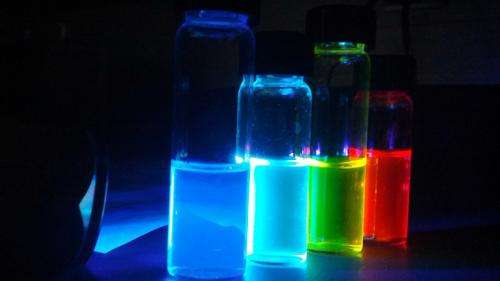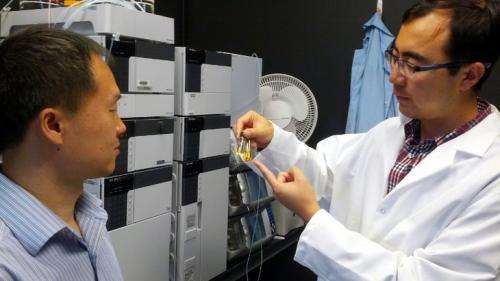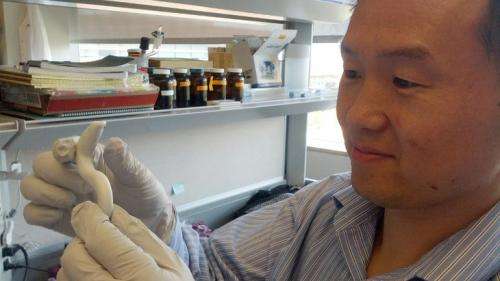Novel chemistry turns conventional polymers into biomedical supermaterials

Biomaterials are crucial to the development of many modern medical devices and products including biodegradable sutures, bone screws, pins, rods and plates, and scaffolds for regenerating bone, cartilage and blood vessels; and with each new discovery comes a chance to solve yet-unmet clinical challenges.
As new, innovative research drives the evolution of biomaterials toward increasingly sophisticated applications, the functional requirements of those materials have expanded to include both therapeutic and diagnostic elements – with particular focus on optical imaging capabilities, where Huck Institutes faculty researcher Jian Yang and his Transformative Biomaterials and Biotechnology Lab have recently made several revolutionary innovations.
Polylactone materials
"My lab focuses on developing materials that can be used for 3-D printing and regenerative engineering," said Yang. "Polylactones – such as polylactic acid (PLA) – are one of the few types of biodegradable polymers that have been widely used in FDA approved medical devices such as orthopedic fixation devices, tissue engineering scaffolds and drug-delivering micro- or nano-particles. We are innovating this material by making it intrinsically photoluminescent without adding traditional photobleaching organic dyes or cytotoxic quantum dots. That was a challenge previously, but we've managed to do it now."
By modifying the PLA polymer to be intrinsically fluorescent, the Yang Lab has made a biodegradable material that can also be useful in bioimaging, diagnosis, sensing and other related applications.
Cancer management
In one of their research projects, the Yang Lab makes the PLA polymer into nanoparticles that can carry chemotherapeutic drugs to target cancerous tumors.
"Because the cell membranes of cancer cells overexpress folate receptors," Yang explained, "we can target those cells and tumors with our nanoparticle by conjugating folic acid on its surface; and now that our nanoparticle is fluorescent, we can also use it to image the tumors via fluorescence imaging."
Yang adds that during surgery, however, a doctor can only see down to roughly millimeter-sized tumors with the naked eye, and so another problem arises: there are other cancerous cells surrounding the tumors that the doctor cannot see, and if those cells aren't also removed, then the cancer will return.
"We needed a better way to detect smaller-sized tumor cells and cell clusters," Yang recalled, "and since fluorescence imaging is a very sensitive tool, it can be used to detect those cells that cannot be seen with the naked eye. Our nanoparticles can target the tumor cells, and then we can use fluorescence imaging to illuminate those cells for surgical removal."
"We've also used the fluorescent PLA polymer to create what we call 'dual-imaging' nanoparticles for cancer treatment," he continued, "meaning that we can encapsulate both cancer drugs and magnetic nanoparticles in our fluorescent PLA nanoparticles in order to use them for both magnetic resonance imaging (MRI) and fluorescence imaging. MRI has become a very popular tool in cancer treatment since it can be used to look deep into the body and rapidly locate solid tumors; then the fluorescence imaging enables doctors to identify small cancer cell clusters around the tumor areas."
Because these nanoparticles have two functions, for both therapeutic drug delivery and diagnostic imaging, they are known as theranostics – a portmanteau word combining therapeutic and diagnostic – but Yang's fluorescent PLA polymer isn't just limited to these roles, either.
Regenerative engineering
The same fluorescent PLA material can also be used for regenerative engineering.
Yang notes that biodegradable polymers are often used to make temporary scaffolds for tissue regeneration, where the scaffolds are placed in the body to recruit cells – sometimes pre-seeded with cells before implantation – and will then degrade and eventually be absorbed by the body; so for different applications, Yang explains, he wants to design materials with different specific degradation rates.
"For example," he said, "in bone regeneration, we may want the material to degrade over six months or a year; but in wound healing, we may want the material to degrade over a couple of months."
So the question, according to Yang, is first how to determine materials' degradation rates, and then how to design materials that can match the need for specific degradation rates in vivo.
"When we design a material to degrade over a specific period of time," he explained, "we test it in the lab with an incubator and buffer solution set at 37ºC and 7.4 pH to simulate normal conditions inside the body; this allows us to rapidly assess the rate of degradation in vitro, but in vivo situations are very different and so this poses a challenge."
Many factors in the body, such as enzymes and other biomolecules, influence materials' degradation rates, and so, Yang stated, "our in vitro understanding cannot be translated directly in vivo; we need to do in situ monitoring to assess how materials actually degrade in vivo."
Now that they have made a material that is intrinsically fluorescent, the Yang Lab can do non-invasive imaging for real-time in situ monitoring of the material's degradation: as the fluorescent signal becomes weaker over time and eventually disappears, its decay can be translated into the rate of the material's degradation without ever needing to re-open the body.

Still – in many cases, even when the body is re-opened, it can be difficult to measure a material's degradation.
"If we are making a material to be porous," Yang explained, "then the body's tissues grow through the material and it becomes impossible to differentiate the native tissues from the material."
But, Yang said, when those tissues grow into the fluorescent biomaterial, their interaction may change the fluorescent signal, and so it may be possible to correlate that signal change with the tissues' growth into the material.
"In other words," he concludes, "we may also have a way to measure tissue regeneration in addition to measuring material degradation, and therefore we can better design our materials to meet specific medical needs."
This work is published in the July 9 issue of Advanced Materials.
Citrate-based materials
Elastomeric scaffolds
Scaffold materials are also needed that mimic the elastic nature of soft tissues such as those found in the bladder, lungs, skin and blood vessels, and this need has led the Yang Lab to work on developing new citric-acid-based biodegradable elastomeric polymers.
Unfortunately, Yang explains, many such materials are mechanically weak, and they become even weaker when fabricated into medical devices, which severely limits their use.
"Current methods used to strengthen these biomaterials sacrifice the limited functional groups available for future bioconjugation/functionalization," he said, "and also slow down the materials' degradation rate. So my lab is focused on creating citric-acid-based materials that are elastic in nature and effectively balance the desired mechanical properties, functionality and degradation through innovative chemistry known as 'click' chemistry."
Click chemistry, Yang explained, involves the use of two chemical groups which "click" together like a lock and key to strengthen materials without sacrificing their degradability or functionality.
"We have used this approach to develop a new soft, elastic and strong biodegradable material," he said, "by introducing a secondary cross-linking mechanism which provides strong intermolecular bonding and thus improves our material's mechanical properties by making it much stronger overall."
This work is published in the March 26 issue of Advanced Materials.
Bone-inductive orthopedics
Yang's rationale behind developing citric-acid-based materials, he explained, is based on recent evidence suggesting that citric acid plays an important role in bone development, physiology and structure.

"Recent research has found that citric acid plays important roles in controlling the formation of the mineral structures that give our bones their high strength," he elaborated. "In addition, my lab's previous research has shown that citric acid – whether located in biomaterials or released during the course of those materials' degradation – can direct stem cell differentiation into bone cell lineages and accelerate those cells' maturation."
"We set out to develop citric-acid-based biodegradable materials," Yang continued, "with the rationale that citric acid can be released over the course of a material's degradation and used by the body for enhanced bone development and regeneration. In addition to providing the damaged site with citric acid, the chemistry of citric acid also allows us to incorporate bioceramics to better match the mineral content of native bone, where previously developed materials have been very brittle and weak."
Yang postulates that the natural existence of citric acid in the body and its importance in bone physiology hint that it should be considered in the design of orthopedic biomaterials and medical devices.
"The whole idea of our click chemistry work," he explained, "is to make a mechanically strong, biodegradable polymere that also has intrinsic bone-inductive properties, since most other biodegradable polymers don't have the intrinsic ability to induce bone regeneration. In the past 30 years, even though people knew that citrate was present in natural bone, very few biomaterials researchers considered citrate as a catalyst for bone regeneration. We started to realize that this might be a niche in bone biomaterials design."
So the Yang Lab began studying how stem cells interact with citrate-based polymers, even supplementing citrate into the stem cell culturing medium in order to observe its influence on stem cell differentiation.
"We found a lot of compelling evidence," Yang said, "showing that citrate influences stem cell differentiation into osteoblasts along with several other osteogenic factors; but most importantly, we found that citrate synergizes with these growth factors in the body to further influence stem cells' differentiation into osteoblasts. We also found that, in vivo, our citric-acid-based materials work to both induce bone regeneration and reduce inflammation, and now we are working to identify the molecular mechanisms involved."
This work is published in the May 28 issue of Journal of Biomedical Materials Research A.
Tailored degradation
The Yang Lab is also developing citrate-based polymers with unique degradation profiles – for example, that will degrade slowly at first and then faster in later stages.
"Materials provide mechanical support for tissue regeneration," Yang explained, "so they should be strong in the beginning; but when the tissues start growing, then the materials should begin to degrade."
In addition to their unique degradation profiles, the Yang Lab's bone composite materials can be made to exceed the strength of the cortical bone (the exceptionally dense, hard outer layer) by forming composites with calcium-containing apatite crystals in the body; as a result, these materials are suitable for extreme load-bearing functions – for example, replacing or reinforcing sections of long bones such as the femur.
"We can even make our polymers with extra bonding sites on the surface," Yang said, "so we can use click chemistry to react our materials with proteins or peptide molecules, creating surface modifications to further improve biocompatibility and functionality – for example, to promote attachment of endothelial cells to forming blood vessels in order to improve vascularization in our 3-D tissue engineering scaffolds."
Success by multifunctional design
By designing multifunctional materials, the Yang Lab is improving the potential for complex surgical and other medical procedures to be performed concurrently through a single product or device and without the need to re-open the body in order to monitor progress.
"We hope," Yang concluded, "that these innovations will help to overcome some of the major hurdles in biomaterials development – by conferring novel properties and functions on existing materials, and also by advancing development of new materials that can be tailored to very specific purposes. As a result, we should begin to see medical products and procedures that work and integrate better to produce superior outcomes for doctors and patients, alike."
More information: Guo Y, Tran RT, Xie D, Wang Y, Nguyen DY, Gerhard E, Guo J, Tang J, Zhang Z, Bai X, Yang J. 2014. "Citrate-based biphasic scaffolds for the repair of large segmental bone defects." J Biomed Mater Res Part A 2014:00A:000–000. DOI: 10.1002/jbm.a.35228
Xie, Z., Zhang, Y., Liu, L., Weng, H., Mason, R. P., Tang, L., Nguyen, K. T., Hsieh, J.-T. and Yang, J. (2014), "Development of Intrinsically Photoluminescent and Photostable Polylactones." Adv. Mater., 26: 4491–4496. doi: 10.1002/adma.201306070
Guo, J., Xie, Z., Tran, R. T., Xie, D., Jin, D., Bai, X. and Yang, J. (2014), "Click Chemistry Plays a Dual Role in Biodegradable Polymer Design." Adv. Mater., 26: 1906–1911. doi: 10.1002/adma.201305162
Journal information: Advanced Materials
Provided by Pennsylvania State University



















